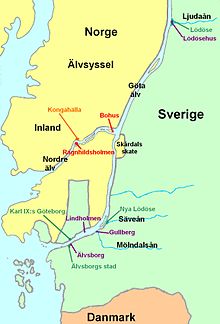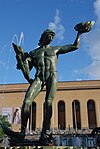History of Gothenburg

The history of
The Göta Älv has been of crucial importance throughout Swedish history as the country's only direct outlet to the North Sea, and thus to the wider world beyond the Baltic Sea. However, for many centuries the borders with Norwegian Bohuslän and Danish Halland ran right up to the river mouth, making Swedish settlements in the area extremely vulnerable to attack. The threat was significantly reduced by the conquests of both Bohuslän and Halland in the mid-seventeenth century, which gave Gothenburg the security to expand into Sweden's largest port and one of its main industrial centres.
Prehistory

The southwestern coast of the
When the Kingdoms of
Predecessors of Gothenburg

Lödöse
The earliest predecessor of present-day Gothenburg was the town of
Lödöse is also mentioned several times in the
The whole river was so beautiful to see,
As if one saw colours of shining gold,
When the famous king's men steered their ships to Lödöse.
Lödöse had a major disadvantage in that it was located upstream of the Norwegian fortress at
Nya Lödöse

In 1473, the Swedish regent Sten Sture the Elder tried to establish an alternative settlement downstream of Bohus, at the confluence of the Säveån river with the Göta Älv, in order to prevent the fortress from interfering with Swedish trade. Formally it was known as Göthaholm, but it soon came to be called "New Lödöse" (Swedish: Nya Lödöse), as many of the first inhabitants were former citizens of (Old) Lödöse.[8]
However, the new location (in what is now the
Älvsborg Town
Älvsborg Castle had originally been built in the 1360s at the mouth of the Göta Älv.[9]
In November 1545, King Gustav I decided to relocate Nya Lödöse to a site directly adjacent to the castle so that the town could benefit from its protection. The relocation of the townspeople was effected in summer 1547, and on 30 July of the same year the new town is attested in documents for the first time, with the name "Älvsborg Town" (Swedish: Älvsborgs Stad).[10]
However, in 1563, at the outbreak of the
The Gothenburg of Charles IX

In 1607 Gustav's son, King Charles IX, founded a new settlement directly across the Göta Älv from Älvsborg, on the south side of the island of Hisingen, in what is now the district of Färjenäs. It was named Göteborg (Gothenburg), and was the first settlement to bear this name.
Charles's Gothenburg was almost wholly inhabited by Dutch merchants and immigrants, and Dutch was the official language within the town. The settlers were attracted to Sweden with the promise of free trade and freedom of religion. They enjoyed privileges such as 20 years of tax exemption and lowered customs rates. In return, Sweden and the west coast could benefit of the skills and trade connections of the Dutch.[13]
However, Gothenburg proved to be just as vulnerable to Danish-Norwegian attacks as its predecessors at Nya Lödöse and Älvsborg Town, indeed arguably even more so, as part of Hisingen (Hisings skipreide) was in fact Norwegian territory at this time. Soon after the outbreak of the Kalmar War, on 12 June 1611, the town was attacked and burnt by a Danish-Norwegian force.[14]
Foundation of Gothenburg

In 1621,
As at Charles IX's Gothenburg, the majority of the initial inhabitants of Gustav Adolf's Gothenburg were immigrants, and above all from the Dutch Republic. Indeed, the initial city council comprised ten Dutchmen, seven Swedes and one Scot.[16] Dutch builders were contracted to plan the new city and construct its fortifications, in part because of their expertise in building on marshland. In order to drain the swampy ground and provide access for shipping, Gothenburg was given a network of canals, akin to those of Dutch cities like Amsterdam, and indeed it appears the plans for the canal network were modelled on those used for the recent Dutch colonial settlement of Batavia (modern Jakarta, Indonesia).[17] The Dutch influence over Gothenburg in its early decades was so strong that it was sometimes regarded as a Dutch colony on Swedish soil; for example one contemporary writer described it as, Gotheburg ab Hollandis aliisque Belgis incolitur ('Gothenburg, inhabited by Hollanders and other Belgians')[18][19]

Over time, however, more and more native Swedes started to move to the city, and they soon represented a majority of the population. This demographic shift is reflected by the fact that the city council became homogeneously Swedish after 1652, when the last Dutch councillor died.[20]
During these first few decades of its existence, Gothenburg also acquired a
Under the Treaty of Roskilde (1658), Denmark–Norway ceded the Danish province of Halland and the Norwegian province of Bohuslän to Sweden, thereby moving the frontiers with both Denmark and Norway away from the Göta Älv and leaving Gothenburg in a much less exposed position. The city was subsequently able to grow into an important port, in part due to the fact that it was one of only two ports on the Swedish west coast (the other being Marstrand), which was granted the right to trade with merchants from other countries.[20]
Early modern Gothenburg

During the
At the beginning of the
The harbour developed into Sweden's main harbour for trade towards the west, and was the main port of departure for
Modern Gothenburg

With the 19th century, Gothenburg evolved into a modern industrial city that continued on into the 20th century. The population increased tenfold in the century, from 13,000 (1800) to 130,000 (1900). In the 20th century, major companies that developed included SKF (est. 1907) and Volvo (est. 1926).
In more recent years however, the industrial section has faced a recession, which has spurred the development of new sectors such as increased merchandising, tourism and cultural and educational institutions. [citation needed]
The city acquired a
In June 2001,
See also
Notes
- ^ Clara Nevéus and Bror Jacques de Wærn: Ny svensk vapenbok, Streiffert, Stockholm 1992, p. 70
- ISBN 91-85488-09-7
- ^ Burenhult, G. 1999. Arkeologi i norden, del 1. Natur och Kultur. Stockholm. Sidan 200
- ^ Olsson, Gunnar, "Sverige och landet vid Göta älvs mynning under medeltiden", Göteborg, 1953
- ISBN 91-974119-2-2
- ^ www.nad.riksarkivet.se, Diplomatarium Sueceanum #468.
- ^ af Ugglas, Carl (1931). Gamla Lödöse. Historia och arkeologi. Gothenburg. p. 33.
{{cite book}}: CS1 maint: location missing publisher (link) - ^ Historisk-statistisk beskrifning öfver Göteborg: från dess anläggning till närvarande tid, Carl Magnus Rydqvist, C F Arwidsson Tryckeri, Göteborg 1860 s. 3-4 (taget direkt ur Privilegiebrevet)
- ^ Berg, Wilhelm (1902). Elfsborgs slott. Gothenburg.
{{cite book}}: CS1 maint: location missing publisher (link) - ^ Göteborg förr och nu, Göteborgs hembygdsförbunds skriftserie IV, utgiven av Göteborgs hembygdsförbund 1966, s. 35ff, "Vad krönikor kan ställa till — Nya Lödöses flyttning till Älvsborgs slott på 1540-talet," av Ralph Scander.
- ^ Larsson, Lars-Olof, Arvet efter Gustav Vasa, Prisma, 2005.
- ISBN 978-0-543-93900-5
- ^ Scander, Ralph (1975). Karl IX:s Göteborg på Hisingen: en holländsk koloni med svenskt medborgarskap. Göteborg förr och nu, 0348-2189 ; 10. Gothenburg: Göteborgs hembygdsförb.
- ISBN 91-7029-161-6.
- ^ Sandström, Anna (1908). Natur och arbetsliv i svenska bygder, Volume I. Götaland. pp. 294–5.
- ^ "Gothenburg's History & Heritage". Gothenburg Tourist Centre. Retrieved September 1, 2020.
- ^ "Goteborg.com - Travel - Articles - Gothenburg - Castle of the Goths". Archived from the original on 2010-12-16. Retrieved 2011-01-24.
- Nordiska museet, Stockholm 1923, s. 14
- ^ Specimen academicum historiam urbis Gothoburgi breviter exhibens …, [Staden Göteborgs historia], Haqvin E Setthelius, Uppsala 1715
- ^ ISBN 91-24-16635-9.
- ^ Berättelser ur Göteborgs Historia under Nyare tiden, [1809-1860], Hugo Fröding, Medéns Bokhandel, Göteborg 1924, s. 82
- ^ Lars Ericson, Lasse i Gatan - Kaparkriget och det svenska stormaktsväldets fall. Historiska Media: Lund 1997 s. 193ff, 232ff, 239ff
- ^ "Welcome Aboard The Swedish Ship Götheborg" (PDF). soic.se. 2013.
- SELIBR 11614816.
- ^ House of the Emigrants Archived 13 January 2016 at the Wayback Machine .
- ^ "Göteborg spårväg - Svenska Spårvägssällskapet".
Further reading
- OL 14046005M
- "Gotenburg", Norway, Sweden, and Denmark (8th ed.), Leipsic: Karl Baedeker, 1903, OL 16522424M

